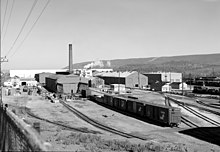Altoona Works
 Juniata Locomotive Shop at Altoona Works in 1988, during the Conrail era. | |
| Location | 9th Ave. at 13th St., Altoona, Pennsylvania |
|---|---|
| Coordinates | 40°30′48″N 78°23′59″W / 40.51321°N 78.39985°W |
| Built/founded | 1850–1925 |
| Governing body/ | Norfolk Southern Railway |
| PHMC dedicated | October 5, 1996 |
Altoona Works (also known as Altoona Terminal) is a large railroad industrial complex in Altoona, Pennsylvania. It was built between 1850 and 1925 by the Pennsylvania Railroad (PRR), to supply the railroad with locomotives, railroad cars and related equipment. For many years, it was the largest railroad shop complex in the world.
History
In 1849, PRR officials developed plans to construct a repair facility at a town newly established for this purpose, Altoona. Construction was started in 1850, and soon a long building was completed in the 12th Street area that housed a machine shop, woodworking shop, blacksmith shop, locomotive repair shop and foundry.
The 12th Street area facilities were replaced later by the Altoona Machine Shops. The first locomotive was built there in 1866. A total of 6,783 steam, diesel and electric locomotives were manufactured in Altoona between 1866 and 1946.[1]
In time, additional PRR repair facilities were located in Harrisburg, Pittsburgh, Renovo and Mifflin, and the Altoona Works expanded in adjacent Juniata. Inventor Alexander Graham Bell sent two assistants to the Altoona shops in 1875 to study the feasibility of installing telephone lines.[citation needed]
In 1875, the Altoona Works started a testing department for PRR equipment. In following years, the Pennsylvania Railroad led the nation in the development of research and testing procedures of practical value for the railroad industry.[2] In 1905, a Stationary Testing Plant was installed at Altoona, after originally being installed and used for locomotive testing in 1904, as one of the PRR System exhibits at the Louisiana Purchase Exposition in St. Louis. Locomotives tested on the plant included T1 4-4-4-4 No.6110[3] and Baldwin No. 60,000[4] Use of the testing facilities was discontinued in 1968, and many of the structures were demolished.[citation needed]

In May 1877, telephone lines were installed for various departments to communicate with one another.[5]
In the 1920s, the site consisted of 125 buildings on 218 acres (0.88 km2), and the shops employed over 16,000 workers.[6][7] Portions of the complex are still in use by Norfolk Southern Railway (NS).[citation needed]
During World War II, PRR facilities (including the Altoona Shops) were on target lists of German saboteurs involved in Operation Pastorius. They were caught before they could complete their missions.[8] By 1945, the Altoona Works had grown to be one of the largest repair and construction facilities for locomotives and cars in the world.[9]
Current facilities
Today, NS runs a locomotive shop at Juniata with about 450 employees.[citation needed] The Railroaders Memorial Museum is next to Altoona Works.
Major facilities (1920s)
- Altoona Machine Shops (renamed 12th St Car Shop in 1928)
- Built steam locomotives during 1866-1904
- Later in the 20th century it handled locomotive repair and manufacture of engine parts
- Altoona Car Shops
- Built 1869
- Manufactured freight cars and passenger cars
- Juniata Locomotive Shop

- Built 1888-1890; expanded 1924-25
- Built steam and electric locomotives during 1891-1946
- Included a paint shop, boiler shop, blacksmith shop, boiler house, erecting shop, two-story machine shop, electric and hydraulic house, two-story office and storeroom, paint storehouse and gas house, and hydraulic transfer table and pit.
- Repair work only in the mid-20th century
- Builds and remanufactures locomotives today
- South Altoona Foundries
- Map of Altoona Works

See also
References
- ^ "Norfolk Southern Railway: Timeline". Norfolk Southern Corporation. Archived from the original on 15 March 2012. Retrieved 2008-09-05.
- ^ "History of the Altoona Railroad Shops National Park Service Special History Study Chapter 1: History of the Altoona railroad shops (continued)13. Changes after World War II". National Park Service Special History Study. United States National Park Service. 2004-10-22. Retrieved 2008-03-04.
- ^ "Locomotive And Railway Preservation" The Magazine of Historic Railwaay Preservation, Number 9, July-August 1987, ISSN 0891-7647, p.22
- ^ "Part Two - Baldwin 60000".
- ^ "History of the Altoona Railroad Shops Chapter 1 Heading 7 The Altoona Railroad Shops After The Civil War Paragraph 10". National Park Service Special History Study. United States National Park Service. 2004-10-22.
- ^ Alexander, Edwin P. (1967), The Pennsylvania Railroad: A Pictorial History, New York: Bonanza Books, p. 133
- ^ Paige, John C. (1989), “A Special History Study: Pennsylvania Railroad Shops and Works, Altoona, Pennsylvania,” Washington, DC: United States National Park Service.
- ^ "Railfan's Guide to the Altoona Area". www.trainweb.org. Archived from the original on 9 October 1999. Retrieved 2007-08-24.
- ^ "Chapter 4: Significance and Recommendations for Future Research 1. Significance of Altoona Works". National Park Service Special History Study. United States National Park Service. May 1989.
External links
- Historic American Engineering Record (HAER) No. PA-108, "Pennsylvania Railroad, Altoona Works"
- HAER No. PA-230-A, "Altoona Car Shops, Fire Engine House No. 8"
- HAER No. PA-230-B, "Altoona Car Shops, Foreman's Office & Stores"
- HAER No. PA-230-C, "Altoona Car Shops, Cabinet, Tin & Machine Shop"
- Buildings and structures in Altoona, Pennsylvania
- Conrail
- Industrial buildings and structures in Pennsylvania
- Locomotive manufacturers of the United States
- Manufacturing plants in the United States
- Norfolk Southern Railway
- Penn Central Transportation
- Pennsylvania Railroad
- Rail infrastructure in Pennsylvania
- Railway workshops in the United States
- Historic American Engineering Record in Pennsylvania
- Altoona, Pennsylvania
- Blacksmith shops
- Manufacturing companies based in Pennsylvania

